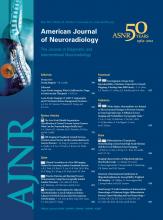With less than stellar success of immediate intra-arterial therapy for acute stroke, Cloft1 mentions the need for “penumbra imaging” or advanced imaging to aid in management decisions. CT and MR approaches to such imaging are still not used by many interventionalists. There is more than just a side interest for acute stroke imaging protocols to be performed before such urgent management decisions. The goal of acute stroke therapy is the treatment of patients with ischemic brain to minimize infarct progression while not intervening when infarction is already complete.
For decades, imaging was performed to exclude other causes of stroke, parenchymal hematoma, mass, subdural hematoma, and seizure foci. Present day management decisions need imaging protocols with the following features: 1) demonstration of the intracranial arteries, extent of ischemia, and extent of completed infarction; 2) ability to be carried out promptly, conveniently, consistently, and accurately; and 3) immediate availability, facilitating management decisions for treatment (whether intra-arterial or intra-venous treatment).
Simple reliance on a NCCT and NIHSS threshold to inform clinicians of the presence and possible proximal location of a thrombus is not dependable for distinguishing ischemia from completed infarction. Although a higher NIHSS score may be seen with more proximal occlusions, a recent study of 699 patients demonstrated that 55% of patients with significant occlusions had an NIHSS score of ≤10,2 with a sensitivity for detection of a proximal occlusion in only 48% by using an NIHSS cutoff of ≥10.3 Similarly, high NIHSS scores can be seen without vessel occlusions in ≤30% of patients.4
Cloft1 states that penumbra imaging is still at the research stage without a consensus of approach. Consensus is not always the proper judge of research evidence. The value of CTP and CTA in conjunction with acute stroke imaging is widely reported.1,5⇓⇓⇓⇓⇓⇓⇓⇓⇓–15 Informative structural and physiologic data can be obtained quickly for acute stroke presentations. Rapid acquisition is needed to meet the “Time is Brain” rally cry of acute stroke treatment.
We propose that acute CT protocols currently have a practical advantage over MR imaging protocols. Despite the uncontested sensitivity of DWI for core representation, primary MR imaging–based acute stroke protocols are rarely performed in tertiary institutions. Magnetic safety precautions, longer scanning duration, and concerns for managing potentially restless or unstable patients within the confined magnet environment limit MR imaging as a technique in the acute stroke setting. Time is expended on stringent safety checks, impractical for unaccompanied dysphasic patients, ironically necessitating CT head screening for orbit evaluation and a CT body scout for implant exclusion before MR imaging. These considerations and limited access to acute MR imaging in many centers render MR imaging impractical to direct immediate stroke management. Even expert sites in advanced MR stroke imaging begin with NCCT and commonly commence IV-rtPa on the basis of clinical presentation and NCCT alone before MR imaging. A protocol delaying thrombolysis after baseline NCCT pending DWI volume estimation amounts to a delay in time to treatment and undervalues the role of CT perfusion in infarct core estimation.
Acute CT stroke protocols (for our team, noncontrast CT, CTA arch to vertex, CTP, and postcontrast CT [PCCT]) need 2 minutes of scanning, little more than the time for noncontrast CT alone. The technical success of acute CT protocols requires organizing CT technologists to do efficient CTA and CTP postprocessing. Our team has >20 trained CT technologists able to perform and process acute stroke protocols 24/7 with standard CTA reformats as quick maximum-intensity-projection multiplanar reformations and CTP maps. Emerging data support CTP use to identify infarct core and at-risk ischemic tissue. Several challenges remain, including the optimal processing technique and determination of thresholds that best predict radiologic and clinical outcome. Yet, there is a convergence of data showing that both CBF and CBV thresholds demonstrate high correlation with DWI core,16⇓–18 while CBF, time-to-maximum (T-max), and mean-transit-time thresholds correlate with penumbral tissue.16,19
A number of core surrogates facilitate interpretation of perfusion maps, including early ischemic changes on NCCT and hypoattenuation on PCCT. Ischemia is shown with CBF and CTA source images on modern CT scanners when CTA is performed first.9 Irrespective of precise tissue-specific thresholds, a large mismatch identifies candidates ideal for revascularization.20,21 Consideration of multiple available CT sequences increases confidence for correct stroke diagnosis among inexperienced readers22 and may facilitate identification of stroke mimics.23 The renal safety of iodinated contrast and radiation dose concerns are addressed in acute stroke CT.24⇓⇓⇓⇓⇓⇓–31 Last, CT-based protocols have cumulative data to widely apply to strokes, safely and cost-effectively.32,33
Neurointerventionalists are strongly motivated to treat occluded vessels, spurred on by case successes, despite lack of notable overall statistical success, as reviewed by Cloft.1 State-of-the-art full stroke imaging seems key for high-level interventional techniques to more appropriately select candidates likely to improve with revascularization. Practical issues relating to expertise in image acquisition and postprocessing potentially may limit wide use for vascular and physiologic imaging. Incomplete imaging of patients with stroke can result in an inability to determine suitable candidates for intravenous thrombolytic or interventional treatments. Improved patient selection could optimize time-consuming, staff-intense, and expensive interventional neuroradiology normalized ratio procedures. This change would allow improved allocation of these services and avoid futile procedures that expose patients only to risk, without chance for benefit.
References
- © 2012 by American Journal of Neuroradiology












